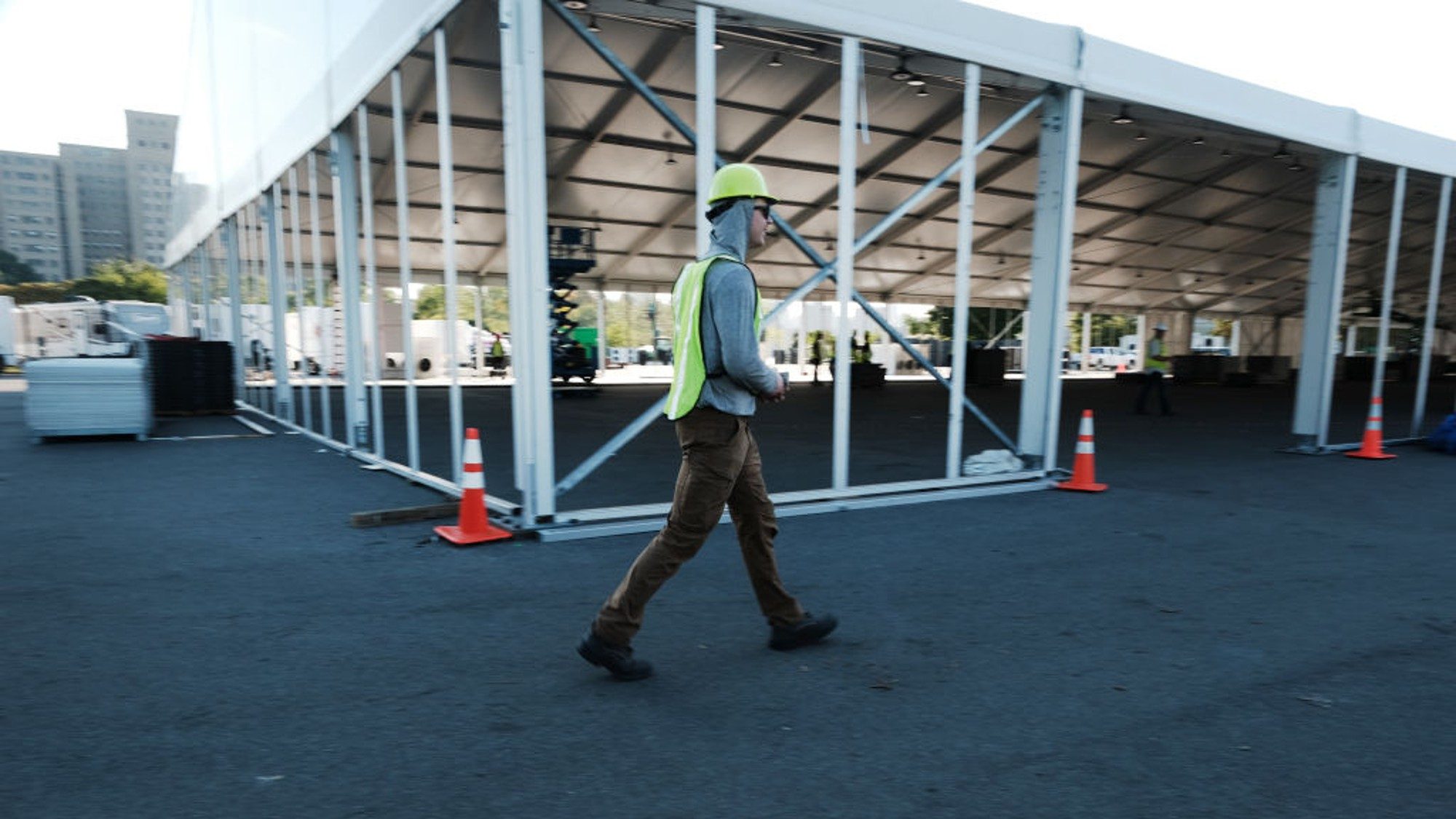Number of immigrants seeking to cross into the US could double 2:20
(CNN Spanish) --
In the United States, a country whose history was forged to a large extent by immigrants, the discourse against foreigners who arrive in search of better opportunities does not subside.
However, the words of those who portray immigrants as a threat do not hold up: Studies, such as one recently published by the George W. Bush Institute, clearly show that these communities benefit the nation's economy as a whole and the pockets of the natives in particular.
The immigration crisis on the southern border and the policy of the Joe Biden administration do not leave the front pages in the United States.
In fiscal year 2022, the record for encounters with migrants at the border that unites the country with Mexico was broken.
And that when Title 42 was still in force — the public health policy that allowed officials to reject migrants at the border since the start of the pandemic — which is nearing its end according to a court decision.
Meanwhile, the government has a program underway to allow limited entry for Venezuelans who are leaving their country en masse.
The debate on the advantages and disadvantages of immigration — which often overlooks the economic, violence and security problems that force millions to leave their homes — is the order of the day.
And the answers from the non-partisan organization's study are clear: on multiple economic and quality-of-life indicators, cities with "relatively large immigrant populations perform better than those with smaller percentages of immigrant populations," the research says, which shows its positive impact in areas ranging from income to cultural development and debunks widespread myths about immigrants, for example that they take jobs away from locals or lower wages.
US federal judge blocks title 42 0:59
More immigrants, more income
In large metropolitan areas and counties with more immigrants, almost everyone's income is higher than in those with fewer immigrants, according to the report.
This correlation does not necessarily imply a cause-effect relationship, because it could be that places with higher incomes attract more immigrants, and not the opposite.
However, the study authors believe that it is the presence of immigrants that influences earnings for a number of reasons, including that metropolitan areas that have had relatively large increases in immigrant populations and linguistic diversity have subsequently seen wage increases. better than average, according to studies by the University of California and Bocconi University in Milan cited by the George W. Bush Institute.
advertising
How does it impact the wages of those born in the United States?
Reference studies have shown that the presence of more immigrants in cities translates into better wages for most groups of workers.
Metropolises with high rates of low-skilled immigrants have seen slight declines in the wages of US-born high school dropouts (according to just under 5% of the workforce), but increases of the wages of those born in the United States in the groups of workers with higher education levels, the report says.
What's more, cities that have a "large sudden influx of immigrant workers do not typically see lower-skilled native-born wage drops," the study says, citing as an example the arrival of more than 100,000 Cubans in the Miami area during the Mariel boatlift of 1980 which "had no lasting effect on the income of the natives".
The opposite is also true: cities where, for example due to immigration restrictions, there is a disproportionate decline in immigrants do not show improvements in the wages of those born in the United States with few qualifications.
These data have simple explanations: low-skilled immigrants who recently arrived in the United States generally do different jobs than most natives, the flow of immigrants attracts business investment that also benefits the native-born, and immigrants support local businesses. also as consumers, details the report.
Americans double the probability of being imprisoned compared to undocumented immigrants 2:45
A report from the National Foundation for American Policy recently published by CNN reinforces the idea that immigration does not take jobs from Americans.
Their research "examined the labor markets where the most temporary foreign workers were employed before the pandemic and found that the drop in H-2B admissions did not boost labor market opportunities for U.S. workers, but rather, if anything, made them worse."
The Pew Research Center, for its part, estimated in 2017 that with the baby boomer generation set to retire en masse, the United States would need a steady stream of immigrants to sustain its growing workforce for the next two decades.
How is the income of immigrants?
Immigrants earn less than those born in the United States.
In 2019, for example, the median income in the 100 largest metropolises was 11% lower for foreigners than for natives, according to a study by the George W. Bush Institute, and was estimated at US$ 65,000.
However, the truth is that the average is not representative since incomes "vary tremendously" between metropolitan areas.
In 2020, for example, they went from a median per household of $136,000 in the San Jose, California area to $31,000 in McAllen-Edinburg, Texas.
The innovation factor and entrepreneurship
Cities with high percentages of immigrants are more innovative than others, and the contribution of people not born in the United States is high.
Immigrants, for example, invent new products and receive patents at higher rates than natives.
27% of master's and doctoral students in the area of Science, Technology, Engineering and Mathematics (known as STEM in English) are foreigners with temporary visas.
What is more: immigrants represent 14% of the population of the metropolises, but occupy 23% of positions in the STEM area.
Other data?
Companies founded by immigrants make up more than 40% of all startups in the country's top tech hubs.
To innovation we must add the entrepreneurial spirit.
Immigrants represent between 22% and 25% of all private business owners in the metropolises, when they do not reach 15% of the population, according to the American Immigration Council, citing the study.
In fact, they are 30% more likely to start a business than those born in the United States, according to an economist at the University of California, Santa Cruz cited in the report, and their companies are more likely to become exporters than others, according to economists from Harvard University.
A 2020 report from the National Bureau of Economic Research already provided statistics along these lines: Researchers reviewed more than a million new businesses formed between 2005 and 2010 and found that twice as many immigrants than native Americans started businesses, which which in turn created employment.
The contribution of immigrants is reflected in some particular areas such as biotechnology and basic services.
In this category, 36% of all accommodation and food service businesses are immigrant-owned, as are 31% of all personal care service businesses.
essential jobs
Immigrants fill millions of essential jobs that would likely go unfilled if they were not in areas like healthcare, manufacturing, technology and construction.
(In fact, this September, as Florida Governor Ron DeSantis was sending a plane full of Venezuelan immigrants to Martha's Vineyard, Florida business owners explained their difficulties finding employees. The United States had 11.2 million job openings that month. employment, according to the Bureau of Labor Statistics)
Its importance in the health area was revealed in the pandemic.
Approximately one in three jobs in this category are filled by immigrants.
In manufacturing, for example, workers have helped "stabilize" industries in the Midwest, filling a shortage of skilled labor that would have forced factories to close.
In construction, on the other hand, immigrants make up more than 70% in the Dallas-Fort Worth area, to name just one example.
The drop in immigration rates since the outbreak of the covid-19 pandemic contributed to labor shortages and consequently increased construction and housing costs.
Florida is, once again, a precise example: after the passage of Hurricane Ian, the non-profit organization Resilience Force confirmed that immigrants from different parts of the country would arrive at the place to help in the reconstruction work of the devastated areas.
And the benefits go far beyond the economic: immigrants make the cities where they find themselves more attractive from a cultural point of view, says the study, impacting areas such as food supply, art and sports.
stabilize the population
The increase in immigrants has prevented many cities and metropolitan areas from significantly declining populations in recent decades, and this, in turn, has allowed local businesses and urban centers to be maintained and revitalized.
"Twenty-eight of the 100 largest metropolises in the United States would have lost population between 2010 and 2021 if immigration from abroad had not occurred," the study says.
They have also contributed especially to the development of university cities.
Where do immigrants fare better?
To determine in which metropolis immigrants are doing better, the study produced an index that takes 12 variables into account.
These include, for example, income, educational level, financial well-being, and percentage of homeowners, among others.
Among the 25 areas where immigrants are doing best are the top five tech hubs in the United States (San Jose, San Francisco, Seattle, Washington, and Boston) and five second-tier tech or financial hubs (Raleigh, Madison, Bridgeport -Stamford-Norwalk, Colorado Springs and Atlanta).
With reporting from CNN's Vanessa Yurkevich, Biran Fung, Priscilla Alvarez, Phil Mattingly and Sofía Benavides.





/cloudfront-eu-central-1.images.arcpublishing.com/prisa/465AE263VBEDPFXJV5HSYQKDGM.jpg)


/cloudfront-eu-central-1.images.arcpublishing.com/prisa/N32QBNMEAGJFI4NXT32PTC3GUY.jpg)

/cloudfront-eu-central-1.images.arcpublishing.com/prisa/2C5HI6YHNFHDLJSBNWHOIAS2AE.jpeg)




